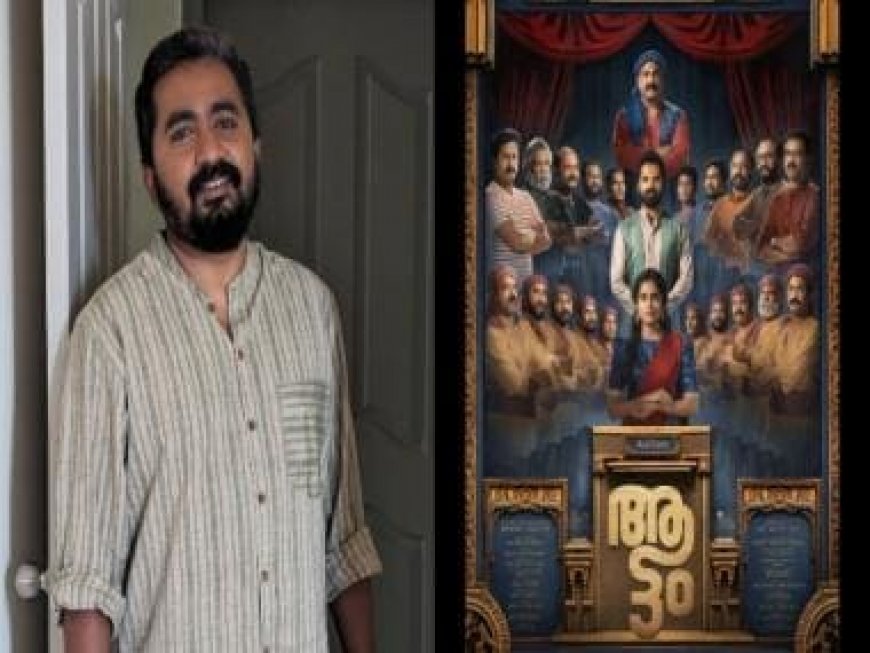EXCLUSIVE! Aattam explores if truth is a pursuit of an individual or a group: Director Anand Ekarshi
EXCLUSIVE! Aattam explores if truth is a pursuit of an individual or a group: Director Anand Ekarshi

Aattam is an ensemble film that is a slow burner. There are multiple main characters with contrary perspectives, clashing views and most of these characters are men. There is just one female main character, and at first sight, this seems like an imbalance. However, Anand Ekarshi, the director and writer of Aattam has managed something interesting with his film. Anjali, the female lead begins on equal footage like any other main character and it is as the film progresses that she transforms into the protagonist of the film. In our conversation with the director, he revealed interesting details about the film including the fact that unlike other films where the story comes first, here, he had finalized the cast before.
“I know that most of the films are made from an idea and then it develops into a story and then you cast. I wish I was also able to say something like that. However, the truth of the matter is, over here, all the people that you saw in the movie are my friends. We all came from the theater background and we used to work for a theater group, except the actress and the actor who plays Hari’s character — Kalabhavan Shajohn. So in this film, the story was written for the cast.” He explained that the film was written for them and how the cast had been finalized much earlier than the story was formulated. He also trusted in his friends to fit the roles in the films because of their exemplary work in theater. The one thing that they did have to work on, was to understand acting for the camera vs being on stage. To aid in this, the actors took part in rehearsals that went on for 35 days.
Now, speaking of the story, Ekarshi explained that the idea of this film comes from this thought. Truth —- if it is a pursuit of an individual or if it is a pursuit of a group. Can a group collectively pursue truth or justice. In addition to this, there is also the question of what is the space of justice when your personal desires are at stake. He said, “It is because this is a group vs individual idea, I thought we already have eleven men, so obviously the individual has to be a women. This is the scenario from which the idea was developed.”
You may wonder if one woman is enough in terms of representation, considering this is an ensemble film. Howeeever, the fact that the story also concentrates on this imbalance makes this choice all the better. One woman in a theater group that otherwise consists of men is the basic setting of the film. So, Anjali’s thoughts, her actions are in keeping with this power dynamics in mind. In fact, this imbalance plays a role in the film’s progression as well. Now, can a male perspective of the female psyche really be enough to portray the nuances required of such a film? Did Ekarshi collaborate with women writers on the project? The answer is no. He explains, “I wrote the female character with people around, and the personality within me also. Women have been a part of my life all throughout, so I did not seek them specifically for the film.” So how was he certain that Anjali would be relatable to the women around? He says, “I was certain because I narrated the story. I did to a lot of women and a lot of women related to it. So it is more than enough for you to go ahead.”
Truth is relative and seeking justice stems from different places — of love, compassion, or empathy. So there is so much nuance to the set up of the film, yet Ekarshi is managed to make it not only immersive but also relatable to a large extent. Speaking of how he was successful in making this film immersive, Ekarshi explained, “You are always keeping the audience in mind. You are not forgetful of the audience when you are writing, not to a point where they are interfering but you are mindful of them, and you are mindful of the fact that it needs to immersive, it has to connect with them, it has to be engaging. It is not a space to show off your prowess at writing. You are writing for the audience, you are not doing it for yourself. So, I think this awareness really helps in writing.”
Then what about the nuances? What was it like to translate these nuances on screen to ensure relatability? “It was about identifying the prevalent perspectives that are already there in society. Like if a crime is committed, there are ‘n’ number of perspectives that exist in the society, So I was trying to incorporate as many as possible so that every individual stands out, and so that every individual represents somebody from the audience. This is in case of the men. In case of the woman character, I conceived her character as grey till a point where she stands up for truth. So she is grey, and she like any normal person in the world and she does things that are conceived as problematic or wrong in the eyes of the society. She goes through her own conflicts as well. Yet, she stands for the truth and only then she becomes the protagonist. Otherwise, she could be judged just as the other men in the film are judged.”
Priyanka Sundar is a film journalist who covers films and series of different languages with a special focus on identity and gender politics.
What's Your Reaction?


























































